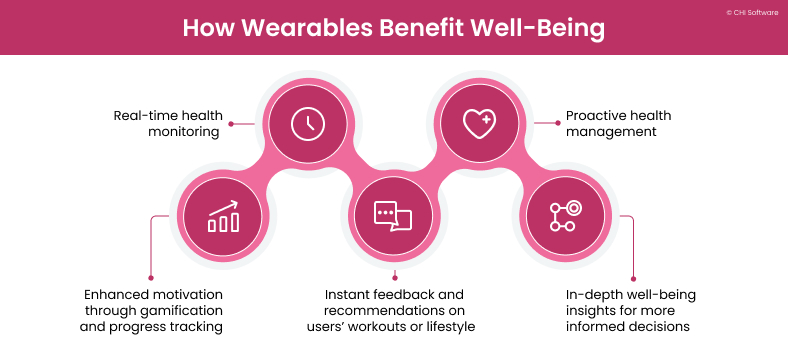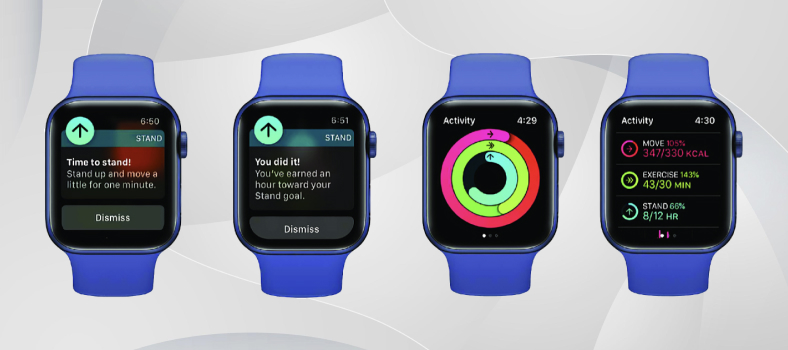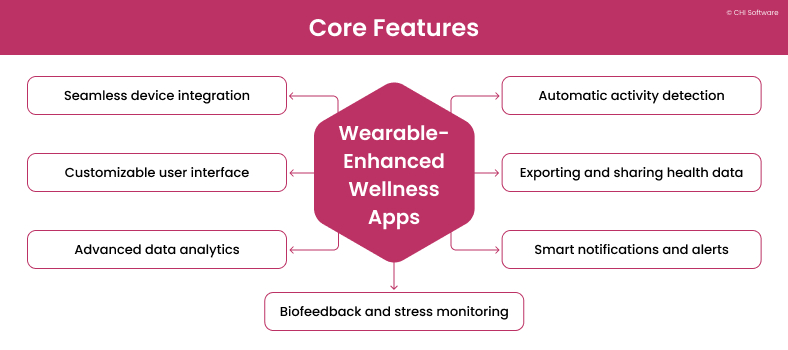Health is a concern for people of all ages, especially in a fast-paced world like today’s. Have you ever wondered how you can track your health in a continuous, high quality, and invisible way? Well, there’s an app for that.
Wearable technology in healthcare can make a real difference in your life. Smartwatches collect real-time information about vital signs, physical activity, and mental state – and the demand for these and other wearable technologies is only increasing. According to Statista, the smartwatch segment alone will reach a value of USD 11.03 billion by 2028.
That’s why we’ve prepared an in-depth article that explores the advantages and ways of using wearable technologies, to share our experience and tips on developing a healthcare application.
Wearable Device Integration is a Game Changer
The integration of wearables for health data tracking is transforming personal health management. Wearables have many benefits for both users and healthcare providers.

These are the most common advantages for people using wellness apps integrated with wearables.
Real-Time Health Monitoring
Vital signs can be analyzed and instantly synchronized with wellness programmes to provide the user with up-to-date information about their health status. Abnormalities such as irregular heartbeats or changes in sleep patterns can then be detected quickly.
Proactive Health Management
Continuously monitoring various health indicators allows for even subtle signs of deterioration to be noticed in time to make a real difference. This continuous analysis helps healthcare professionals to take preventive measures to reduce the development of diseases.
Proactive health management also means setting goals. These goals can be as diverse as the number of daily steps or sleeping hours. Wellness apps can create visualizations of these paths to motivate each user.
Benefits make new opportunities closer. Start your development project with an easy step.
Drop us a line
Real-Time Feedback
The benefit consists of several elements.
- Users can get feedback on their performance in the middle of a workout, and adjust their intensity accordingly.
- Users can receive immediate recommendations in case of violations or an unhealthy environment. For example, to hydrate or take a break.
- Data from wearables can help to identify the impact of factors such as stress or diet on the body, and suggest ways to address it, for instance meditation.
- Notifications can also remind users of their goals. Seeing their progress, users get a sense of success and a desire to keep going. That’s why visualized reminders are often used on wearable devices.

Example of visualized reminders on smartwatch
Empowerment and Engagement
Wearables and wellness apps empower users to take control of their health. When data is more accessible and understandable, user engagement increases. In addition, healthcare apps extensively use gamification and reminders to help users stay active and motivated.
Data-Driven Decision-Making
Apps can offer recommendations to users based on data collected from different sources. But the real health benefits come when they are used to make doctors’ work easier. Once wearables are synchronized with apps, doctors can use that data to monitor a patient’s daily functioning and health insights and trends, so they can make diagnoses and decisions faster.
Core Features of Wearable-Enhanced Wellness Apps
Thosee benefits are pretty significant, aren’t they? Now, let’s review application features that provide more advantages.

You should consider these features in the first place before starting the development process.
Seamless Device Integration
First and foremost, there should be no barriers between the wearables and health app integration. Supporting synchronization with different brands and models is a big challenge for developers, but it is essential for an optimal experience. It is also necessary to synchronize the user’s data in real-time across all their devices. Easy access to the application via a smartphone or tablet will undoubtedly improve efficiency.
Customizable User Interface (UI)
An app can present complex health data using intuitive visuals like graphs or charts. In turn, users or doctors can customize the indicators on a dashboard. For example, heart rate monitoring through wearables is becoming much easier allowing the user to see their data in a visualized way, and sending reports to doctors.
Gamification in Wellness Apps: Keeping Users Engaged and Motivated
Read more
Advanced Data Analytics
AI-powered wearables also have more advanced analytics capabilities. Machine learning algorithms must be implemented for the app to analyze collected health data, offer predictions, and consider patterns to enable artificial intelligence to identify and track data and gain insights from even the most minor reactions to stimuli that doctors might miss.
Automatic Activity Detection
The app should be able to automatically recognize and record what type of physical activity the user is doing – such as walking, running, or swimming – without them having to enter any manual input, allowing them to go about their day without having to worry about data entry.
Exporting and Sharing Health Data
For users who want to or share medical records with their doctor, the feature of exporting data is crucial . The application should be able to import and export information in various formats to be able to integrate with other necessary applications.
Smart Notifications and Alerts
Smart notifications and alerts are an essential feature. Users can receive notifications on smartwatch about their wellness and fitness goals that adapt to the user’s behavior (e.g., sending more reminders if activity decreases).
The device may also react to deviations from the norm. Suppose, for example, the device detects that the heart rate variability (HRV) is out of the normal range. In that case, the user may receive an immediate notification.
We have engineers to help you building any of these features. Let's discuss the details
Book your call
Biofeedback and Stress Monitoring
Health data analytics from wearables continuously provide physiological information to the app to assess the user’s stress level. Based on the data, the user can receive a notification to start doing breathing exercises or meditations.
Wellness Potential with Wearable-Integrated Apps: Key Use Cases
Smartwatches for fitness and well-being are not the only applications of wearables. What if they could also be used by large companies unrelated to the healthcare sector? Let’s look at some other examples of how these tools are used for digital wellness.
| Use Case |
Details |
| Corporate Wellness Programs |
Employees wear physical activity tracking devices – app has access to each user’s data – app suggests personalized tasks = promoting healthy lifestyle |
| Monitoring of the Postoperative and Rehabilitation Period |
Patients use wearables – doctors can follow health state of patient – patient has personalized recovery guideline with daily updates |
| Chronic Disease Management |
Wearable metrics monitors different health indicators, sends reminders to take medications |
| Remote Health Monitoring for Elderly Care |
Seniors use wearables – family, doctors have real-time data access |
Corporate Wellness Programmes
Integrated health applications have recently been gaining popularity among companies of all sizes that are trying to encourage healthy habits in their employees and help them to regulate their working day.
How does it work? Employees wear physical activity tracking devices, often a fitness bracelet or watch, equipped with step counters, sleep trackers, and even GPS trackers. With access to so much data, the app analyzes each user and offers personalized tasks that promote a healthy lifestyle.
Companies can also use wearables to engage their employees, like creating various challenges to stimulate involvement.
Monitoring Postoperative and Rehabilitation Periods
During recovery after an injury or surgery, patients can use wearables to track the rehabilitation process and follow the guidelines of personalized recovery plans. Now, it is even possible to integrate wearable ECG monitors with apps to provide daily updates and advice to the patient and share vital signs and progress data with healthcare professionals for ongoing support.
Sleep monitoring wearables for wellness apps are also popular after severe injuries or surgeries, as the devices allow for high-level monitoring of the patient’s condition even in a calm state such as sleep.
Chronic Disease Management
Patients with chronic conditions can opt for wearables and wellness apps to manage their conditions. Wearables track metrics such as body mass index (BMI), calorie counting, or glucose levels (for diabetics). A good example is well-known wearable glucose meters, which are now used with an app that monitors blood sugar levels and sends reminders to users to take their medication or adjust their diet.
Remote Health Monitoring for Elderly Care
Thanks to wellness apps with real-time wearable monitoring, caring for the elderly is becoming easier – all seniors need to do is wear an accessory. The family and healthcare professionals will have access to data on their activity, and in case of any issues, the app can alert the family and doctors to the need for help.
It’s an impressive use case, isn’t it? Our team already has experience in developing such products. You can read more about it below.
Enhanced Elderly Care with Wearables: Our Experience
CHI Software is a reliable partner in developing digital solutions for your business. Let’s look at our experience with an example of an existing custom health app integration with wearables.
СHI Software has been operating since 2006, and is growing non-stop. We have already developed many solutions in the healthcare sector. Let’s focus on our development of remote patient monitoring – a healthcare app for seniors.
One of our US-based clients sought a development team to enhance their health monitoring application to make the work of nurses in an assisted living facility (ALF) easier. The solution helped them see each patient’s needs and prioritize their working time.

Wearables can significantly improve the quality of senior care.
All-in-One Update: Emergency Assistance, GPS Functionality, and Wearable Device Sync
Our team added an emergency call and GPS tracking functionality to allow staff, relatives and doctors to track patient’s movements. This directly impacted the level of safety because, in combination with the emergency function, elderly patients can receive help more quickly.
We updated the original life science solution for web and mobile users. Now the application can be synchronized with all popular wearable devices.
Developing Wellness Apps for Seniors: Accessibility and Usability Considerations
Read more
Cross-platform compatibility was one of the main challenges. Our specialists adapted the app for compatibility with all popular wearable devices. Also, the developers added wearable data API synchronization with the server to ensure smooth transfer of information.
Overcoming Developmental Roadblocks: Lessons from CHI Software’s Experience
And now we come to the most interesting question: how to integrate wearables with wellness apps? It’s a time-consuming process, and we’re ready to show you a few of the challenges that you may face. With our insights, these challenges can be anticipated and avoided.

That’s how you can solve the most common challenges when integrating wellness apps with wearables.
Data Accuracy and Consistency
Wearable sensors for wellness tracking may not always provide accurate data. You need to understand that accurately measuring heart rate can sometimes be very difficult in some circumstances. Minor inaccuracies can lead to data inconsistencies in personal health apps across devices.
First, we suggest paying attention to the analysis of devices that will be synchronized with the app. You should integrate error modification methods to correct the data received from the device and make it more reliable.
Data standardization practices should be implemented to ensure uninterrupted communication between wearables and the application. This approach will also make managing and synchronizing data across platforms easier.
How to Create a Health Insurance Mobile Application
Read more
Cross-Platform Compatibility
With so many devices on the market, each with its operating system and API, ensuring that a fitness app runs equally smoothly on different devices can be very challenging. Our advice is to use standardized APIs and SDKs whenever possible, and investing time in thorough testing on different platforms to check wellness app compatibility with fitness trackers in great detail.
Keeping Users Engaged
The best wearables for fitness and health apps have a high level of gamification. Even the smallest devices now contain many animations, graphs, and opportunities to choose their look. Gamification is a great way to keep the user’s attention, and maintain their motivation.
The latest developments in gamification include wellness app integration with smart clothing such as smart sneakers. Satisfying the user’s curiosity is a difficult – but critical – task. Don’t neglect this point: use gamification, personalized insights, goal-setting functions, and regular updates to keep people interested.
Challenges are not that overwhelming with the right development team – with CHI Software.
Contact our engineers
Maintaining the Highest Level of Security
Wearables data synchronization in wellness apps is a complex process involving sensitive medical and personal data., Apps and devices are always a target for potential security breaches – so when working on any fitness app development, especially with synchronization of other devices – pay close attention to:
- Compliance with regulations such as GDPR and HIPAA;
- The implementation of robust encryption methods;
- Secure authentication, which should include several stages.
Conclusion
The benefits of wearables in the development of wellness applications are significant. By synchronizing your app with these small devices, you can improve user engagement and experience and track health for medical and personal purposes.
With an emphasis on seamless integration and privacy protection, the combination of wearables and apps empowers users to take control of their fitness and well-being, leading to healthier and more fulfilling lives.
However, there are many obstacles to synchronizing wearables and applications seamlessly, so you will need a reliable partner. With its deployment of AI-powered wearables for wellness, CHI Software has once again proved its professionalism, expertise and reliability.
Whether you have an idea for an app or already have an app you want to improve, we can help you. Fill out this contact form, and we’ll start our journey.
FAQs
-
How can CHI Software help integrate wearable devices with my existing wellness app?

We offer comprehensive solutions with seamless data synchronization. Here are some of the tasks we can help you with:
- API integration: CHI Software can integrate your app with popular devices using APIs;
- Data analytics: We can develop systems that analyze the collected data and offer personalized information in any format;
- Artificial intelligence and machine learning: This is the core expertise of our company. Therefore, our team is happy to implement AI-based algorithms for more personalized health recommendations;
- Synchronizing IoT or building an IoT system: Our team can synchronize IoT and wearable devices for health or build a collective network;
- Customized solutions: If you're working with less common devices or specialized hardware, CHI Software can create solutions that ensure compatibility and seamless data exchange between devices and your application.
-
What types of wearable devices can be integrated with wellness apps?

Here are the most common wearable devices you can integrate your wellness app with:
- Fitness trackers: Devices like Fitbit and Garmin;
- Smartwatches: Apple Watch, Samsung Galaxy Watch, etc;
- Heart rate monitors: For example, Polar and Wahoo;
- Smart clothing: Items of clothing equipped with sensors, such as those offered by Hexoskin;
- Sleep trackers: Devices designed specifically for sleep monitoring, such as the Oura Ring;
- Blood pressure monitors, glucose monitors;
- Bluetooth wearables.
-
What are the technical challenges of integrating wearables with wellness apps, and how does CHI Software solve them?

Many technical challenges may arise when integrating wearables with wellness software. Here's an overview of some of them and CHI Software's solutions:
- Data compatibility and standardization
CHI Software develops custom integration layers and middleware to unify data from multiple sources. We also leverage APIs and SDKs provided by device manufacturers and create adapters to ensure interoperability.
- Data security and confidentiality
Working with sensitive medical data carries with it a great deal of responsibility for the safety of this essential data. CHI Software strictly adheres to regulations such as HIPAA and GDPR, implementing robust encryption protocols and secure data storage solutions. We also conduct thorough and regular security audits and assessments.
- Keeping users engaged
A user-friendly interface requires careful design to ensure intuitive use. And the introduction of gamification to keep the user's attention is crucial nowadays. This is why our team focuses on developing intuitive and engaging user interfaces. In addition, our team conducts user experience (UX) research to improve the design and functionality of applications.
-
How long does it take to integrate wearables into an existing wellness app?

Of course, each project has its own development timeframe. But we can provide you with some fundamentals about development stages:
- Integration with standard APIs of popular devices and minor changes to the application: 2 to 4 weeks.
- Integration with several devices, significant changes in the application architecture: 4 to 8 weeks.
- Integration with non-standard hardware, in-depth data analysis, or significant changes to the application infrastructure: 8 to 12 weeks or more.
-
Does CHI Software provide API development for wearable device integration?

Absolutely! CHI Software provides API development services, including integration with wearable devices. Get in touch with us and we will offer you a customized solution or create a custom API to connect any device to any applications.
About the author
Ivan keeps a close eye on all engineering projects at CHI Software, making sure everything runs smoothly. The team performs at their best and always meets their deadlines under his watchful leadership. He creates a workplace where excellence and innovation thrive.
Rate this article
32 ratings, average: 4.62 out of 5







